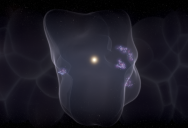Scientists Created A Map Of Our Planet’s “Bubble”
There’s a lot of talk about imaginary bubbles these days – body autonomy bubbles, people living in their own bubbles, et al – but astronomers know Earth actually has one.
Now, they’ve made a pretty map of what it would look like if we could see it from a different vantage point.
The cool 3D map reconstructs the evolutionary history of the “Local Bubble,” which is a 1,000-light-year-wide cavity of cold gas and dust that’s formed all nearby stars – including the sun.

Image Credit: CfA, Leah Hustak (STScI)
It’s the result of a study by researchers from the Center for Astrophysics and the Space Telescope Science Institute, one that reveals all of the stars and star-forming regions within 500 light years of Earth reside on the bubble’s surface.
Catherine Zucker, an astronomer and the author’s lead study, thinks it could be a huge step in better understanding the galaxy.
She talks in a statement about how, although scientists have been aware of the Local Bubble for some time, their discovery was actually an accident.
“It actually started out because we just wanted to make a map of all the major landmarks, basically, in our galactic neighborhood.”
Instead, they noticed that the stars in the Milky Way seemed to be unifying near the bubble’s surface.
They used a software program called Glue and data from Gaia, a space observatory, they created a map of exactly where the stars lie. From there, the team determined the bubble’s origin stems from a series of supernova explosions that took place 14 million years ago.
Gaia was critical, according to the team. The observatory surveys about 1 billion stars (which is less than 1 percent of the stars in the Milky Way), and is on a mission to create the most accurate map of the galaxy.
Their high-quality measurements made this entire study possible.
“Think of the Milky Way as being shaped as a very thin pancake.
As supernova go off in the center of the disk, the bubbles the reaction creates pokes holes on the surface of the ‘pancake’ and influences its structure.
Multiple bubbles can touch and even collide with one another.”
This kind of reaction is what made the team suspect the bubble isn’t a bubble at all, but what they refer to as a “galactic chimney.”
It’s possible if you’re close enough, you can pretty much lose whatever life you have, or at least be affected by it.”

Image Credit: Theo O’Neill/World Wide Telescope
The team also reconstructed the history of the regions where stars were formed, which let them see how the areas evolved. They believe this knowledge will help astronomers understand the role dying stars play in creating new ones.
Adam Frank, physics and astronomy professor who was not involved in the project agrees – and thinks the map is a “beautiful example” of one way new stars are formed.
He also wonders whether or not the research could lead to new revelations about how Earth was affected by exploding supernova.
“One of the things that’s interesting about supernovae and hypernovae is that it’s possible that they can sterilize their local environments.
Because after all, when it comes to the stars, death is simply a rebirth of a kind.
“The life cycle of stars is essential to understanding some of the things that we care most about.
We wouldn’t be here.
Life wouldn’t be possible without … silicon and iron, magnesium, calcium, and all these other elements, which are born inside stars.”
It sounds as if this study could lead to big revelations and a deeper understanding of where our planet began – and perhaps where it is headed, as well.

Sign up to get our BEST stories of the week straight to your inbox.




